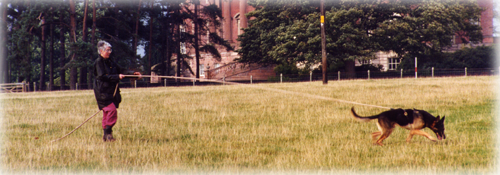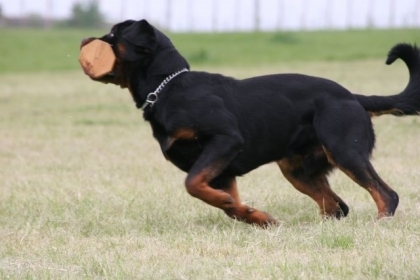 What are Working Trials?
What are Working Trials?
I think it’s fair to say that Working Trials is the pinnacle of The Kennel Clubs sanctioned dog sports in this country. It’s a numerically small sport that been around since the 1920’s.
The easiest way to explain Working Trials is to say that it is the civilian equivalent of Police Dog work - for us of course it is purely for competition. It has also been described as the canine equivalent of Three Day Eventing for horses. All breeds can take part, though smaller dogs are disadvantaged in higher stakes because of the agility section. It is a physically demanding sport, so, whatever the breed, the dog itself must be physically fit - and it helps if the handler is too!
Working Trials are run under Kennel Kennel Club Regulations, and the schedule is constructed so that competitors must qualify for entry from one stake to the next, from Open to Championship Trial.
There are two classes of Working Trials and five Working Trials Stakes, which must be worked in progression. The classes are Open and Championship, with the exception of CD you must qualify at open level before entering a championship trial. i.e to enter a championship UD trial you must have qualified at a UD open trial first. The rules can appear to be a bit complicated and are a major source of confusion to newcomers of the sport.
Nosework
NOSEWORK SECTION 
This carries by far the highest proportion of marks. In the tracking stakes it requires the dog to track human scent for at least half a mile, turning corners, sometimes curves, and negotiating changes of terrain etc, recovering as it goes items of property placed by the tracklayer. The dog and handler are not present when the track is laid, and, depending which Stake is being worked, the track will have been left anything between thirty minutes and three hours before being worked. The weather conditions, wind, and type of terrain play a very important part in the success or failure of competitors, especially on a three hour old track. There is also a property square in this section, in the tracking stakes four articles are placed in a twenty-five yard square area.
Agility
 AGILITY SECTION
AGILITY SECTION
All Stakes: The dogs must jump the obstacles in a controlled manner on command of the handler. When the dog has completed the long jump or clear jump it must remain in a controlled position until the handler joines the dog. During the scale jump thedog must remain in a controlled position on the other side of the jump untill the handler recalls the dog back over the jump.
A Three foot Clear jump:
Video kindly supplied by Dog Friendly
A Nine foot Long jump.
Video kindly supplied by Dog Friendly
A six foot Scale jump
Video kindly supplied by Dog Friendly
The Regulations for C.D. and U.D. Stakes allow the jumps to be lowered according to the height of the dog. Thereafter the full height jumps have to be traversed.
Control Section
CONTROL SECTION
This section is where you need to demonstrate that you and your dog have the necessary bond to work as a team. Although the exercises are fairly self-explanatory the judges are not looking for “Obedience” style precision, in fact that style of precision heelwork will probably find you having your marks docked. However the judges are looking to see that the exercises have been taught thoroughly and can be performed competently. When you consider that the control field at a trial can be anything from freshly cut pasture to 8 inch high stubble and the sendaway can be from 20yds in Intro stake, 50 yards in CD and could be 100 - 200yds or more in higher stakes, it is easy to see that precision is not really practicable.
- Heel free (all stakes)
- Heel on leash (CD and Intro only)
- Recall to Handler (CD and Intro only)
- Steadiness to gunshot (not CD or Intro)
- Sendaway (Intro, CD, UD & WD only)
- Sendaway and Re-direct (TD & PD only)
- Ten minute Down Stay, out of sight (all stakes except Intro)
- Five minute Down Stay, out of sight (Intro only)
- Two Minute Sit Stay, out of sight (CD only)
- One minute Sit Stay, in sight (Intro only)
- Speak on command (TD & PD only)
Speak on Command
Video kindly supplied by Dog Friendly
Introductory Stake
 INTRODUCTORY STAKE
INTRODUCTORY STAKE
The exercises comprise of three sections;
Control Section
- Heel on lead
- Heel free
- Recall to front and finish to heel
Extra commands are allowed throughout the above exercises.
- Sendaway - between 20 – 50 yards
- One minute sit stay
- Five minute down stay
Agility section
- Clear jump (hurdle) to a maximum height of 2’ 6’’ for larger dogs
- Long jump to a maximum of 6 foot
- Scale (over, wait and return) to a maximum of 5 foot
There are reductions in jump sizes for smaller dogs;
- Dogs not exceeding 10 inches at shoulder do 1ft 3inch hurdle, 3ft 3in long jump, 2ft 6in scale
- Dogs not exceeding 15 inches at shoulder do 1ft 6 in hurdle, 5ft long jump, 3ft 3in scale
Nosework
You will not be penalised for extra commands in this section
- Retrieve a dumbbell - present to front, finish to heel
- Elementary search
There are 4 articles placed in a clearly defined area of 15 yards square and your dog must fetch 3 of these articles out to you. You are not allowed to enter the square whilst your dog is working but you can talk to him.
For a list of the available marks

CD Stake
COMPANION DOG STAKE (CD)
This is the starter stake. It is basically a control stake, has no track, just a 13.7m X 13.7m (15yards square)search square containing three articles and 4minutes to recover them.
Although this is a starter stake, that dosn't mean it is easy. It takes a lot of time and dedication to get your dog ready for this stake. Once mastered it will set you up for the rest of your Working trials career.
- Heelwork, on and off lead.
- Retrieve a dumbell
- Recall
- Stays, 10 minute down and 2 minute sit., both out of sight.
- Sendaway
Plus the agility sections
UD Stake
 UTILITY DOG STAKE (UD)
UTILITY DOG STAKE (UD)
UD is the first tracking stake, the track is only half hour old and at least half a mile in length, with two articles placed upon it, one of which must be recovered to enable qualification.
The property search square increases in size to 22.86m X 22.86m (25yards square) with 4 articles and 5 minutes to retrieve them.
At a half hour old it is difficult to teach a dog to be accurate on the track due to the amount of air scent, this is intended to be more motivational and show that your dog has the ability and attitude to get round a track.
- Heelwork, off lead.
- Steadiness to gunshot
- Retrieve a dumbell
- Sendaway
- Ten minute, out of sight, Down Stay
Plus the agility sections
WD Stake
WORKING DOG STAKE (WD)
This a natural progression from U.D. With the age of the track which is now one and a half hours old being the only major difference.
Although the excerises are the same as U.D. the judging criteria is higher. The older track allows the judges to expect more accuracy from your dog
- Heelwork, off lead.
- Steadiness to gunshot
- Retrieve a dumbell
- Sendaway
- Ten minute, out of sight, Down Stay
Plus the agility sections
Example of a WD Track
TD Stake
 TRACKING DOG STAKE (TD)
TRACKING DOG STAKE (TD)
This is the top tracking stake. The track is now three hours old, and at least half a mile in length, with three articles placed upon it, two of which must be recovered to enable qualification.
Property search square of 22.86m X 22.86m (25yards square) with 4 articles and 5 minutes to retrieve them.
- Heelwork, off lead.
- Steadiness to gunshot
- Sendaway and Re-direct
- Ten minute, out of sight, Down Stay
- Speak on command
Plus the agility sections
PD Stake
PATROL DOG STAKE (PD)
The track is now two hours old, and at least half a mile in length, with two articles placed upon it, one of which must be recovered to enable qualification.
Property search square of 22.86m X 22.86m (25yards square) with 4 articles and 5 minutes to retrieve them.
Example of a PD track
Control section:
- Heelwork, off lead.
- Steadiness to gunshot
- Sendaway and Re-direct
- Ten minute, out of sight, Down Stay
- Speak on command
Patrol section:
- Pursuit and Detention of criminal
- Recall from Criminal
- Quartering the Ground
- Test of Courage
- Search and Escort.
Plus the agility sections




